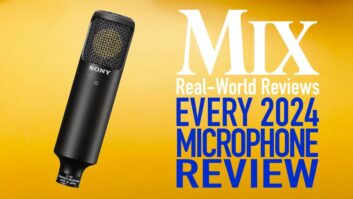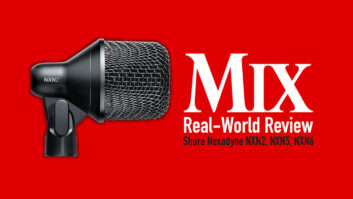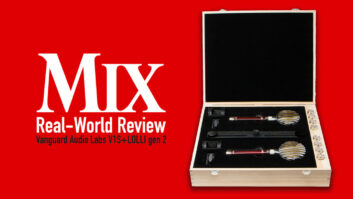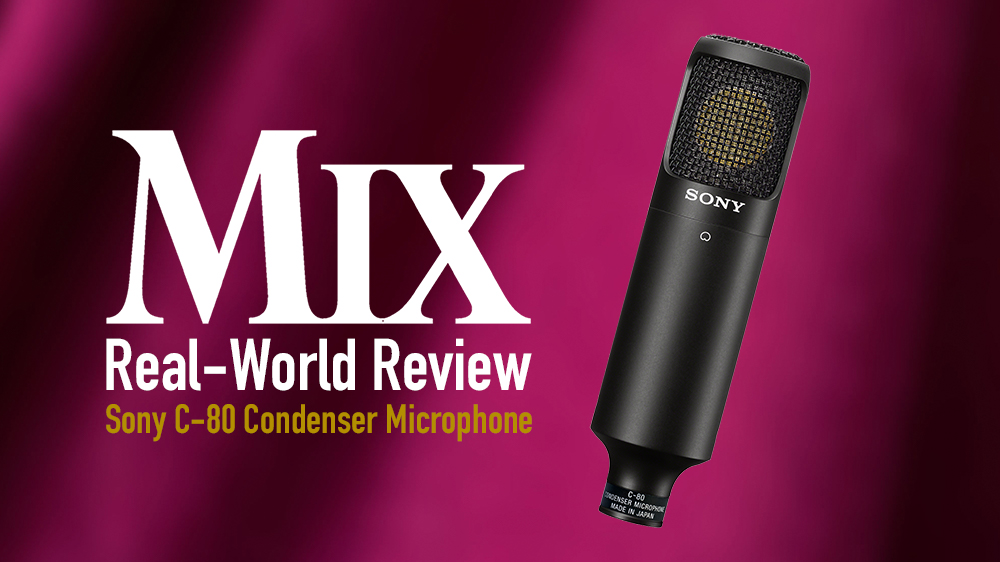
| MIX VERDICT: SONY PROFESSIONAL C-80 UNIDIRECTIONAL CONDENSER MICROPHONE |
| THE TAKEAWAY: “I really enjoyed using the Sony C-80s. They excelled on most of the instruments I recorded including vocals, which I feel puts them into the category of “desert island” microphones.” |
| COMPANY: Sony • https://pro.sony PRICE: $499.99 PROS: • Excellent sound • Solid build quality • Works well on a wide range of sources. CONS: • Shock mount can be difficult to position in tight spaces. • Polar pattern is fixed. |
New York, NY (February 26, 2024)—The C-80 condenser microphone is the latest addition to Sony’s range of high-resolution microphones, which includes the C-100, ECM-100U and ECM-100N. The C-80 employs the same capsule used in the C-100, though astute readers may recall that the C-100 uses a secondary capsule dedicated solely to capturing the ultra-high frequency region.

The mic also owes a nod in the direction of Sony’s wildly popular C-800G, which—even at its premium price—is on a two-plus-year waitlist. It uses the same diaphragm material used in the C-800G, and features technology used in the two-part body developed for the C-800G (“Noise Elimination Construction”) to prevent acoustic vibration, thus reducing noise and increasing clarity.
The C-80 is a side-address mic with -10 dB pad and low-cut (70 Hz) filter switches on the rear. Polar pattern is fixed-cardioid, though at higher frequencies the pattern begins to resemble super-cardioid. Specs for the C-80 include a frequency response of 10 Hz to 20 kHz, maximum SPL greater than 138 dB, and inherent noise less than 12.5 dB. It requires 44 to 52 VDC phantom power for operation, with a current consumption of 4.5 mA. The C-80 ships in a zippered hard-shell case and includes a shockmount. Sony was kind enough to send us a pair of C-80s for this review, enabling use in stereo applications.
Setup of the C-80 was simply a matter of inserting the mic into the shock mount and rotating the knurled collar until the mic was locked into position. The shock mount is made of plastic but holds the mic securely and seems to be well-constructed. On one or two occasions, positioning the mic was a bit tricky due to the size of the basket (see below).
STUDIO TIME
My first session with the C-80s was on a drum kit where they were placed overhead approximately 7 feet high, spaced five feet apart and pointing straight down.
The mics were patched to a Grace m201 preamp and the session was recorded at 48 kHz. The results were great. You could clearly hear the character of the room as well as each component in the kit. Crash cymbals were appropriately brash, and the C-80s perfectly captured the “thwack” of the snare drum (a Ludwig Copperphonic). The kick drum was solid but didn’t produce the deep low end that you expect when close-miking a kick drum, which was no surprise.
My next recording with the C-80s was another session where they were used for drum overheads. This time, the mics were placed 6 feet high and 4 feet apart, facing straight down and patched into Focusrite ISA 110 preamps. The sample rate for this session was 88.2 kHz. Again, the results were very realistic: crystal-clear high end without harshness, and the stereo imaging was pin-point. Even though the ride cymbal and hi-hat weren’t close-miked, they had plenty of presence, and their positions in the stereo field were well-defined (ditto for the toms).
As I expected from the first session, cymbals were smooth, and toms sounded the way they did in the room. In particular, I noticed that the sound of the nylon-tip stick on the ride cymbal was very realistic, but I also felt like I heard more of the cymbal’s overtones than usual (I’ve recorded this same kit many times). I was also able to easily hear accents on the hi-hats as well as differences in the amount of foot pressure on the high hat—i.e. how closed or partially open the high hat cymbals were. A pair of C-80s overhead plus close kick and snare mics could easily be a great minimalist mic setup for drums.
Spurred on by the success of using the C-80s for overheads, I proceeded to try them for close-mic applications on drums. I didn’t love the C-80 as a kick out mic or close snare mic, but placing them close up on toms was glorious. Run through an Avalon AD2022, the C-80s captured a beautiful, round bottom end while also placing the toms clearly in your face. Rejection of cymbals in the tom mics was about average and output was very hot, requiring pads on the mics as well as the mic preamps. Placement of a C-80 on the rack tom was a bit tricky due to the shock mount, but I was able to get the mic very close to where I wanted it.
I had the chance to try the C-80s on two different acoustic pianos, the first being a Yamaha upright. The mics were placed approximately ear-height on either side of the pianist, roughly two feet away and pointing straight at the hammers. The resulting sound was rich and full, balanced across the range of the instrument, and very realistic—there’s that word again—to the point that I could hear the pianist’s fingernails tapping on the keys.
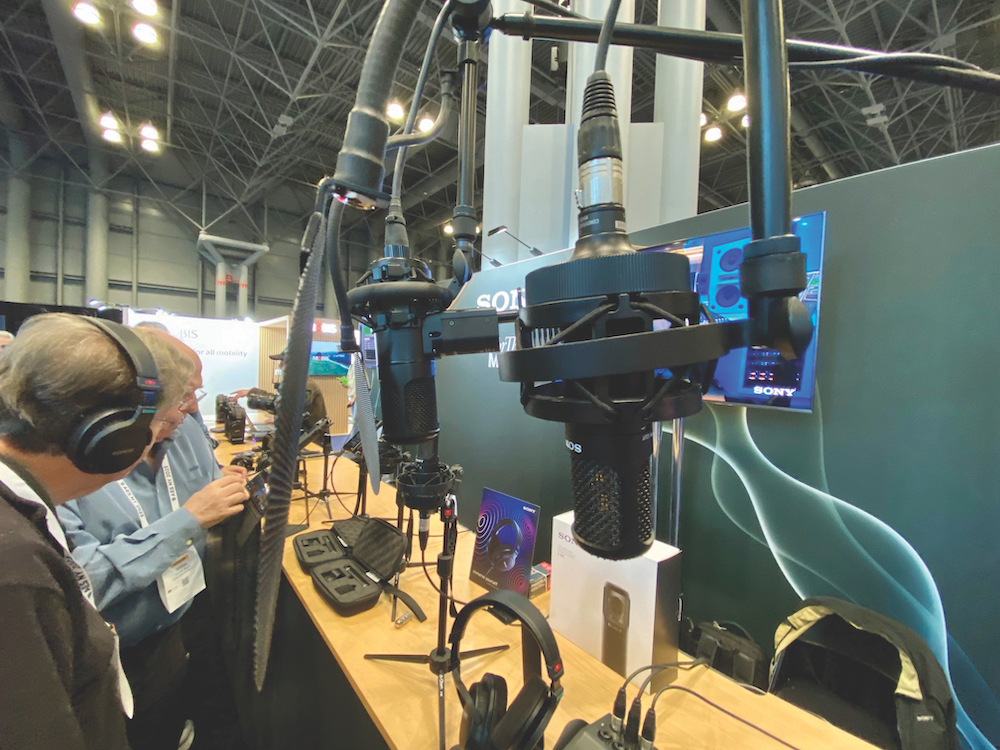
Used to record a Steinway grand piano, the C-80s were placed in XY stereo roughly a foot above the hammers, approximately two-thirds of the way along the keyboard toward the high strings. I initially tried using the mics with the pads off, but heard a bit of distortion on loud passages. Turning on the pads cured the problem (I left the HPFs turned off).
The shock mounts made positioning the mics in XY a bit finicky, but this placement produced a beautifully balanced representation of the instrument. Attack was appropriately sharp during aggressive playing, with plenty of articulation across the range of the instrument and proper balance between the low, mid and high registers. Typical of XY stereo, the stereo image was on the small side and had a solid center.
VOCAL RECORDING
I also used the C-80 to record singer/songwriter Ernest Buckley. Having recorded a lot of work with Ernest, I’m familiar with the sound of his voice through a wide variety of microphones— many of which sound overly sibilant and fail to capture the chesty-ness that he can produce when singing in certain registers. The C-80 fared very well, avoiding sibilance while maintaining articulation and presence—all while producing controlled but rich low-mids and sounding very natural through the midrange.
Proximity effect was noticeable, but subtle and flattering. Once he moved within around 6 or 7 inches of the capsule, the low-mids bumped up a bit but did not make his voice sound muddy, and Ernest agreed that the C-80 was one of the microphones that worked well for his voice.
One of the things I liked about the C-80 was that, even when Ernest moved in close and got loud, the mic didn’t sound strained or like it was running out of headroom. Even though it produces a single polar pattern, it employs dual diaphragms. The dual-diaphragm design results in better control over proximity effect, benefitting vocalists who may not be adept at working a microphone in a recording situation. Some recordists might view the fixed pattern as a limitation, but multipattern mics often end up set to cardioid much of the time anyway.
The C-80’s high-res siblings boast a frequency response that extends out to 50 kHz(!), and while the C-80 may not reach into the stratosphere, there’s definitely more going on than meets the spec sheet. I made several stereo recordings of acoustic guitar at 88.2, 176.4 and 192 kHz, all of which sounded fantastic: balanced across the tonal range, with just the right proportions of body and attack. In particular, one recording of the C-80s in spaced-pair at 192 kHz was practically jaw-dropping in terms of realism.
AudioScape Buss Compressor & 260VU Comp/Limiter — A Mix Real-World Review
I won’t argue whether or not the average bear can hear fundamentals above 20 kHz, but (1) there’s obviously some trickle-down into the audible range that benefits from recording at high sample rates, and (2) I’d rather make my recordings with as much detail and resolution as possible.
I really enjoyed using the Sony C-80s. They excelled on most of the instruments I recorded including vocals, which I feel puts them into the category of “desert island” microphones. Reproduction was consistently clean. They never failed to capture a lot of detail and the two mics were very well-matched in terms of output level and timbre, which resulted in rock-solid imaging when the mics were used as a stereo pair.
It’d be tough to go wrong recording anything with a pair of C-80s, and though they are not cheap, they’re affordable and well worth the price. If you’re looking for a pair of high-quality condenser mics at (or even well above) the price point, you definitely need to hear the Sony C-80.



